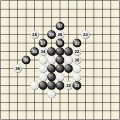Five in a row
Five in a row is a classic strategy game that is known in many countries around the world.
In Europe, five in a row is usually played with pencil and paper. In China it is known as Wuziqi ( Chinese 五子棋 , Pinyin wǔzǐqí ) and is played with Go stones on a board with 15 × 15, 17 × 17 or 19 × 19 fields. In Korea the game is called Omok ( 오목 / 五 目 , "five stones") and in Japan Gomoku narabe ( 五 目 並 べ , German: "string five stones together"). Internationally it is also called Gomoku .
Rules of the game
The game is played on diamond paper or with Go stones on a Go board, often on a smaller board with 17 × 17 or 15 × 15 points. Both players alternately mark a diamond with their symbol (usually with crosses × and circles O) or place a stone of their color on a free point. The winner is whoever is the first to arrange five of his stones in an uninterrupted row. The rows can run horizontally, vertically or diagonally. It depends on the game variant whether you win by forming a row of more than five stones or whether the game is continued in such a case. If the board is completely filled with stones without a winning line being formed, the game ends in a draw.
It has been proven that if there is no mistake, the player who has the first move wins (L. Victor Allis showed this for the 15 × 15 board). The starting player also has a considerable advantage in match practice. You try to compensate for this advantage with different game variants.
Sample game
Gomoku today
Although the game variant Renju was invented to create equal opportunities between the players, there are now significantly more Gomoku players than Renju players worldwide. Experienced players often play five in a row outside of Japan using the Renju opening rules. There are public tournaments such as B. at the Czech Open.
Game variants
- Renju has a special way of opening the game and prohibits the beginning player from certain profitable forms.
- In the gobang , two stones in a row can be knocked in. This version of Gobang is sold under the name Pente in the US and Germany .
- Ninuki Renju unites the rules of Renju and Gobang .
- You can also play five in a row on a hexagonal grid.
- Tic-Tac-Toe and Connect Four are simplified versions of Five in a Row .
- With Connect6 , six stones must be arranged in an uninterrupted row. Each player places two stones per turn.
- The game Yinsh from the Gipf Project is based on the rules of five in a row .
- Pentago is a modern variant of Five in a Row , in which the game board is divided into four rotating areas.
- Since the beginning of the 21st century, several more abstract strategy games have been invented in which several stones have to be arranged in a row. Among other things, Yavalath . However, the strategies and tactics required for these games are often very different from those in Five in a Row .
Individual evidence
- ↑ Renju. (No longer available online.) In: Czech Open. Archived from the original on June 11, 2016 ; accessed on March 30, 2016 . Info: The archive link was inserted automatically and has not yet been checked. Please check the original and archive link according to the instructions and then remove this notice.
literature
- Louis Victor Allis, H. Jaap van den Herik, Matty PH Huntjens: Go-Moku and Threat-Space Search. (PDF; 86 kB) , Report CS 93-02, Department of Computer Science, Faculty of General Sciences, University of Limburg, Maastricht, The Netherlands, 1993, ISSN 0922-8721 .
- L. Victor Allis, HJ van den Herik, MPH Huntjens, MPH: Go-Moku Solved by New Search Techniques. , Computational Intelligence: An International Journal. Vol. 12, No. 1, pp. 7-24. Special Issue on Games. Blackwell Publishers, 1996, ISSN 0824-7935
- Stefan Reisch: Gobang is PSPACE-complete . In: Acta Informatica . tape 13 , no. 1 , January 1980, p. 59-66 .


